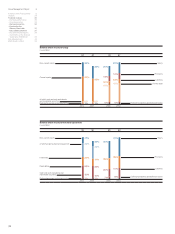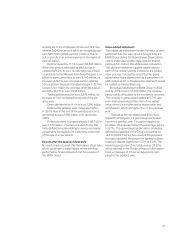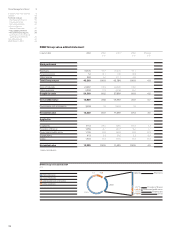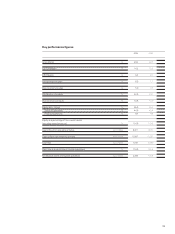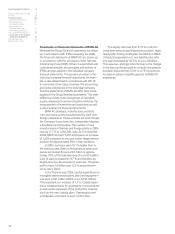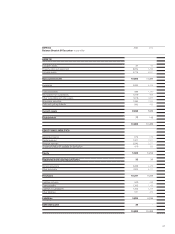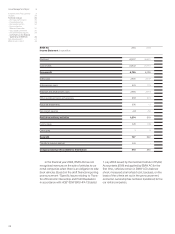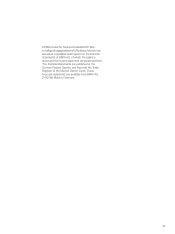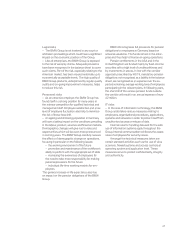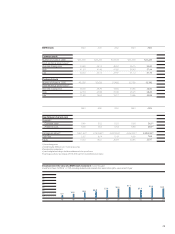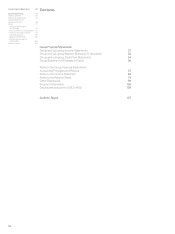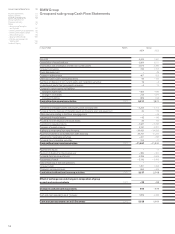BMW 2004 Annual Report Download - page 47
Download and view the complete annual report
Please find page 47 of the 2004 BMW annual report below. You can navigate through the pages in the report by either clicking on the pages listed below, or by using the keyword search tool below to find specific information within the annual report.Group Management Report 8
A review of the Financial Year 8
Outlook 29
Financial Analysis 30
--Earnings performance 30
--Financial position 33
--Net assets position 34
--Events after the
Balance Sheet date 37
--Value added statement 37
--Key performance figures 39
--Comments on the financial
statements of BMW AG 40
Risk Management 44
BMW Stock in 2004 48
46
strikes or poor quality can lead to production stop-
pages and thus have a negative impact on profitability
.
The Group mitigates this risk by means of
extensive selection, monitoring and management
procedures in its dealings with suppliers. Before
selection, for example, the technical competence
and financial strength of potential suppliers are
appraised. A comprehensive Supplier Relationship
Management system also contributes to risk miti-
gation.
Risks relating to the provision of financial
services
– As a consequence of the growth of lease business,
the BMW Group faces an increased residual value
risk on the vehicles which are returned to the Group
at the end of lease contracts. Changes in the residual
values of vehicles of the BMW Group on the used
car markets are therefore constantly monitored and
forecast. The overall risk position is measured each
quarter by comparing forecasted market values and
contractual values per model and market. Provisions
or writedowns are recognised to cover all identified
risks. This risk is also reduced by measures such
as active life-cycle management and management
of used car markets at an international level, both of
which have a stabilising effect on residual values.
– Against the background of Basel II requirements,
the BMW Group is committed to the use of scoring
systems and rating methods to avoid bad debts,
as far as possible. The appropriate processes and
IT infrastructure are continually being developed.
Management tools, including ones based on a
value-at-risk approach, are used to minimise and
control potential losses.
– Operating risks relating to the provision of financial
services are managed by the BMW Group by means
of a process which records and measures risks and
incorporates specific measures to avoid risk. In this
way, the BMW Group minimises the risk of losses
which could arise as a result of the inappropriate-
ness or failure of internal procedures and systems,
human error or external factors.
– Liquidity and interest rate change risks to which
the BMW Groupis exposed are mitigated by matching
maturities and by the use of derivative financial in-
struments. Credit line facilities with various banks
ensure liquidity at all times. Interest rate change risks
are managed using a value-at-risk approach. In addi-
tion, sensitivity analyses are prepared on an on-going
basis to measure the potential impact of interest rate
changes on earnings.
– In order to avoid currency risks, financing and lease
business is refinanced, as a general rule, in the cur-
rency of the relevant market.
– A major part of financing and lease business
within the Financial Services segment is refinanced
on the capital markets. As a result of its good credit-
standing, reflected in the long-standing first-class
short-term ratings issued by Moody’s (P-1) and
Standard& Poor’s (A-1), the BMW Group is able to
obtain competitive conditions.
– A system of local, regional and centralised credit-
decision committees is in place across the BMW
Group, thus contributing to a reduction in the credit
risk inherent to financial services business. Major
loans/credits to dealers and fleet customers are
presented for decision to regional credit committees
or to the central credit committee, depending on
the amount involved. In another measure to reduce
risk, the BMW Group is also working towards stan-
dardised processes throughout Europe to make
credit-decisions and to measure standard risk costs.
These processes have been implemented in 2004
in all European markets where the BMW Group pro-
vides financial services.
The BMW Group uses scorecards to monitor
risk in the area of retail customer financing. Criteria
such as arrears and bad debt ratios are analysed
monthly to provide information about the quality of
the portfolio.


